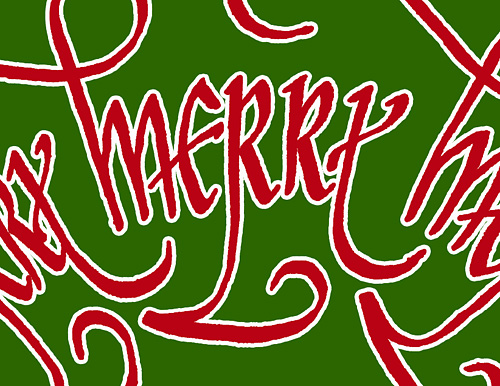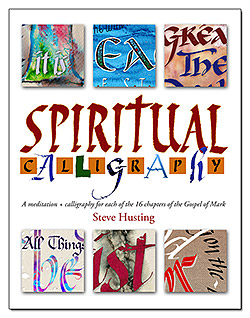I thought I would describe the design process for my 2011 calligraphy Christmas card.
After several false starts, I decided on a circular design, with “Merry” repeated around “Christmas,” flourished inside and out. I was determined to keep it simple with a minimum of retouching. I would do the text by hand and add all the color in Photoshop. I chose the Italic Chancery hand for the “Christ” portion for its simplicity, and the “Merry’s” elongated style, which I haven’t done before, for contrast and fun.
I had already checked the Costco.com site and discovered their 5 x 7″ greeting card service, so that was the proportion I constrained myself to.
I did the project over two nights, one for the sketching and inking (and drying), and the next for scanning and finishing in Photoshop.
I pulled out my circle template that I had designed in Adobe Illustrator 3.0 and used my 2.4mm Pilot Parallel Pen on bond paper to start the Merry text. I easily saw the guidelines through the paper by using my handmade slanted lightbox.
After the “Merry” words were lettered without the swashes, I penciled in the swashes until I got the repeating look I wanted. Then I penned in the swashes.
In the center of the piece, I drew the outside of the capital C in pencil with a compass. I sketched in the inside of the C, then darkened the pencil marks for tracing. I finished the rest of Christ with my 6.0mm Pilot Parallel Pen, then went back to the 2.4mm pen to finish the “mas.” Red was used simply because the pens contained that color at the time. The pen color did not matter at this stage because it was only a sketch.
Satisfied with my sketch, I taped an 8 1/2 x11″ sheet of Clearprint Design Vellum over the design, then traced over the pattern with my dip pens and Higgins Eternal ink. The closest nibs I had to the Parallel Pen line widths were the Speedball C6 and C3 broad nibs. I chose the dip pens for the final piece because I wanted the thinner, crisp lines. Then I traced over the C pencil marks with a Pigma Micron pen, 05 size.
The next evening after the piece was dry, I put it on the all-in-one printer bed and scanned it into Adobe Photoshop CS3 at 300dpi.
I selected the C and copied and pasted it into its own layer. I did the same for “hrist” and “mas,” giving each its own layer, and kept all the rest as one layer, after selecting, copying and pasting the fluorished Merrys as a unit. With everything in its own layer, I could manipulate them individually.
I zoomed in and letter by letter retouched my shaky work, filling in holes in the middle of the letters and smoothing out the most jagged edges. Then I thickened the thinnest lines with a tiny 3-5-pixel brush. I turned off my perfectionism here, otherwise I would be laboring over it for hours. I just accepted the rough, hand-drawn look.
I decided that the complicated fluorished pattern would have better legibility on a plain background, so I made a green background layer, one of the traditional colors for Christmas. I wanted “Christ” to stand out, so I reserved white for those characters. That left red, another traditional color, for the rest of the text. I needed to finish the project quickly to have the cards printed and mailed out, so the traditional color choice was good enough for me.
I selected the fluorished letters and applied a small, bright red outside stroke to thicken it a little. I colored the text with the same color. I later darkened the red to the same value as the background.
I copied the Merry text to another layer, one over the other. I applied a thick white 10-pixel stroke to the bottom version so it bordered the text all around. The white border made the text more lively, but it served another purpose as well. Without the border, the two opposite colors would result in an irritating flicker effect. The border separated the colors enough to eliminate that effect.
I selected the C and colored it red and gave it a black stroke, or border. I copied the layer, selected the bottom copy and gave it a thick white stroke and white outer glow. I did a similar treatment with the “mas,” but with different colors.
I duplicated the Merry layer and colored it black, removing the stroke. Then I enlarged it and shifted it to a new position, and added transparency to melt it into the background. This added a simple texture sweeping across the background.
I saved the design in psd format with the layers left floating. Then I flattened the layers, resized it to 5 x 7″, and saved it in jpg format.
I uploaded it to Costco.com, ordering 10 for $7.99 – just 80 cents a card! Further in the ordering process I learned that I could not pick up the cards at the local store the next day as I thought. I needed to pay $4.99 shipping for mail order to my home. That raised the price of each card, but they were still less than two bucks each.
These will go out to my prison pen pals while the digital version will go out via email to other friends and family.
By Steve Husting, author,
Learn Italic Calligraphy iPhone app, http://itunes.com/apps/learnitaliccalligraphy









